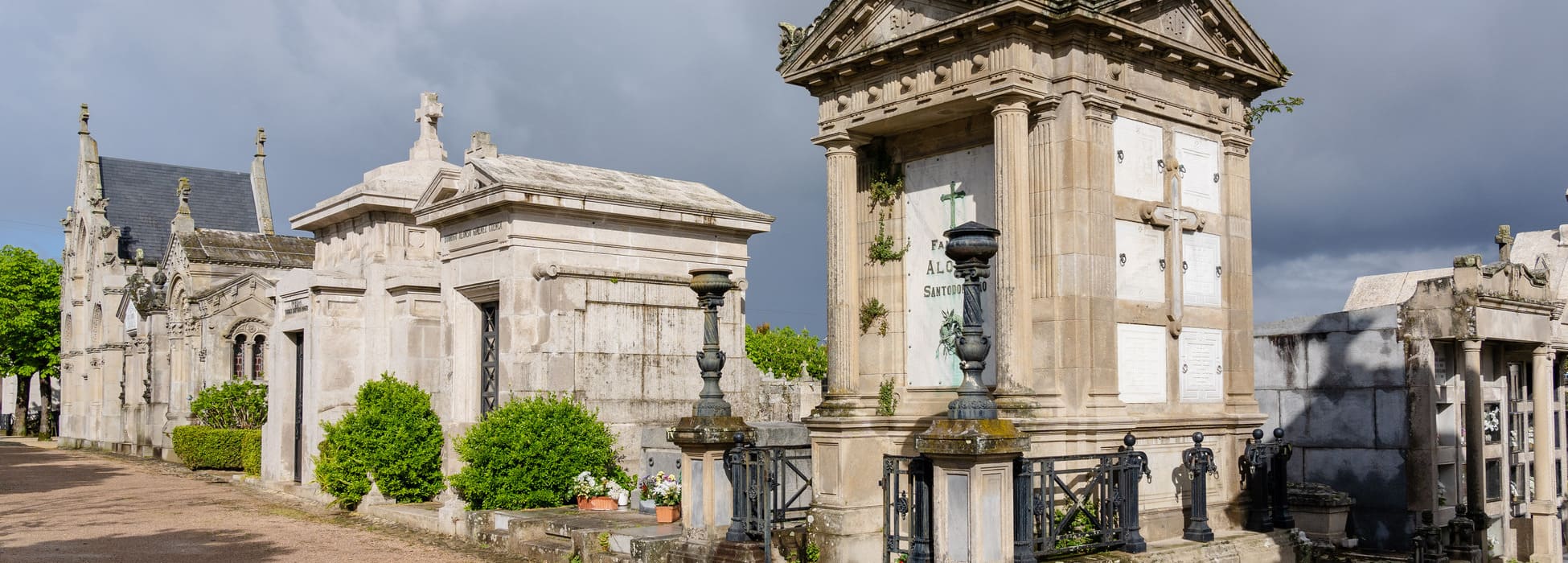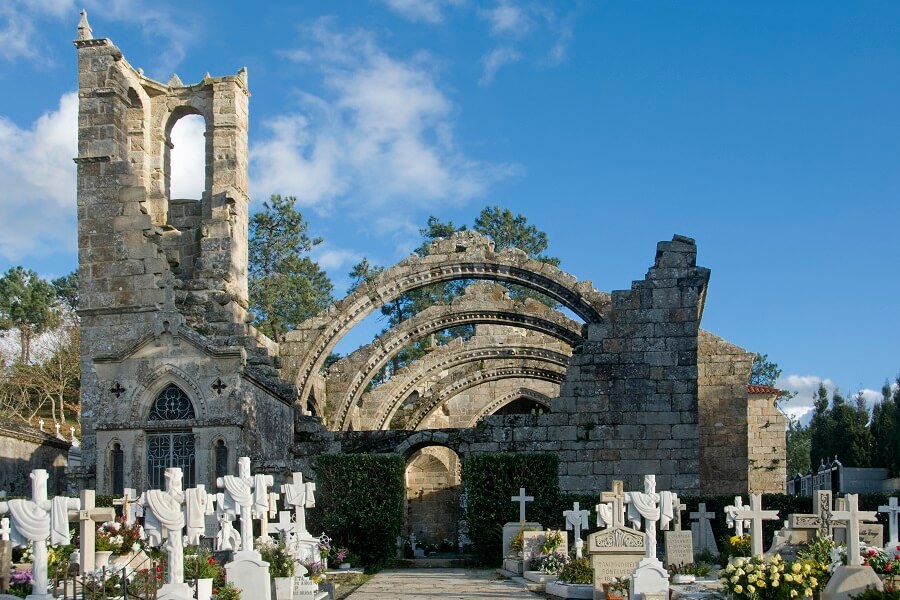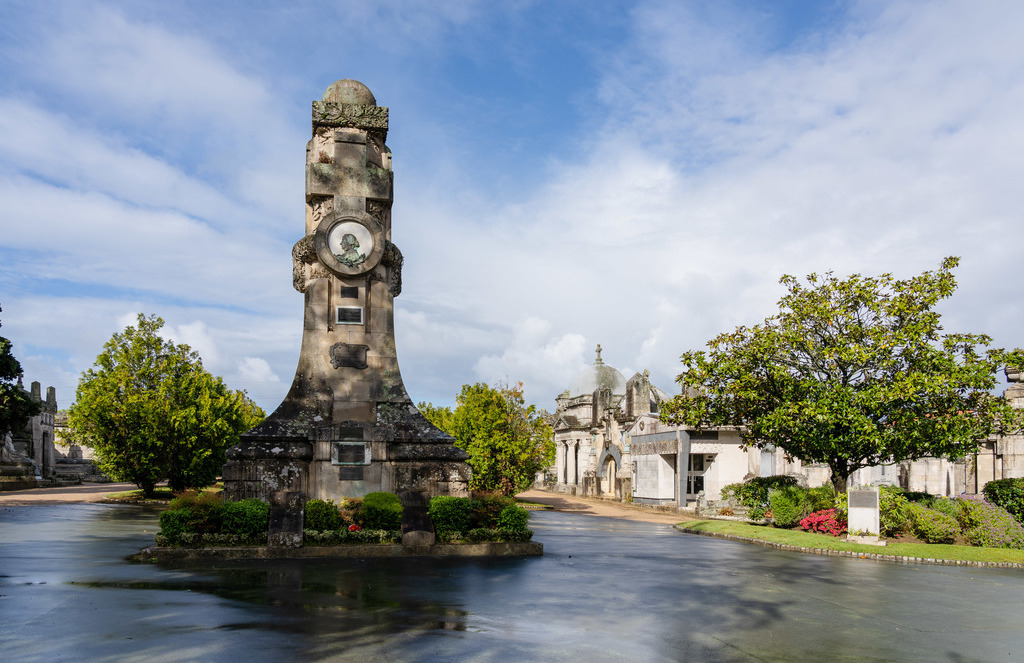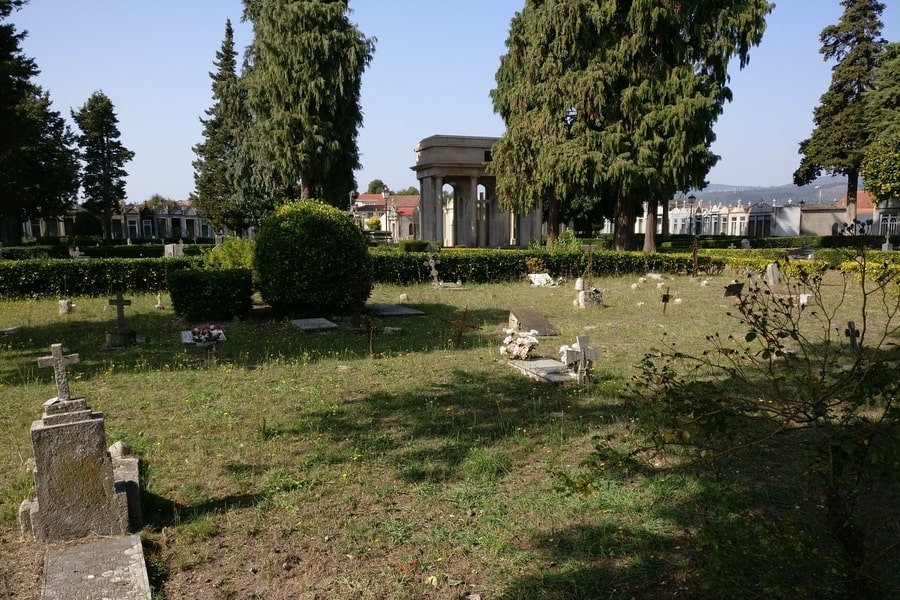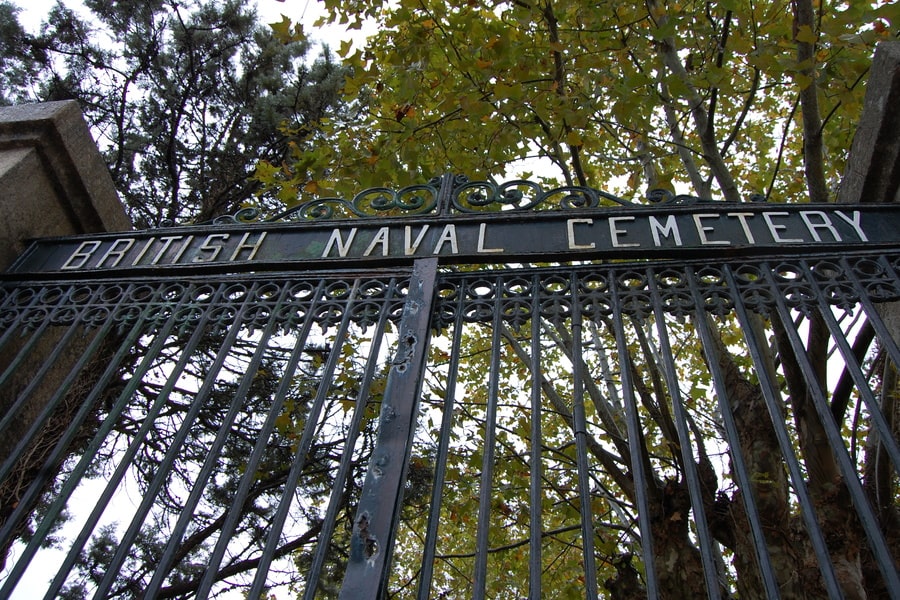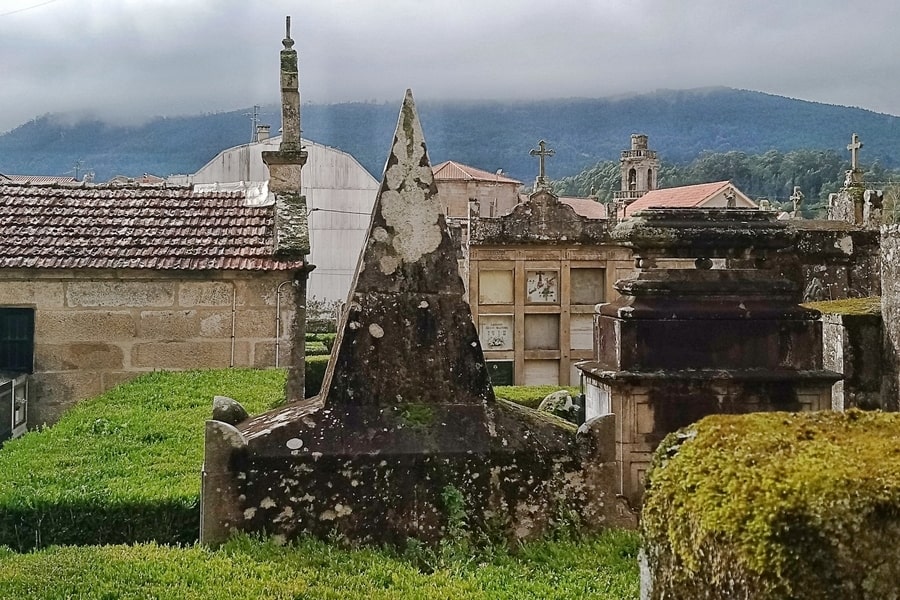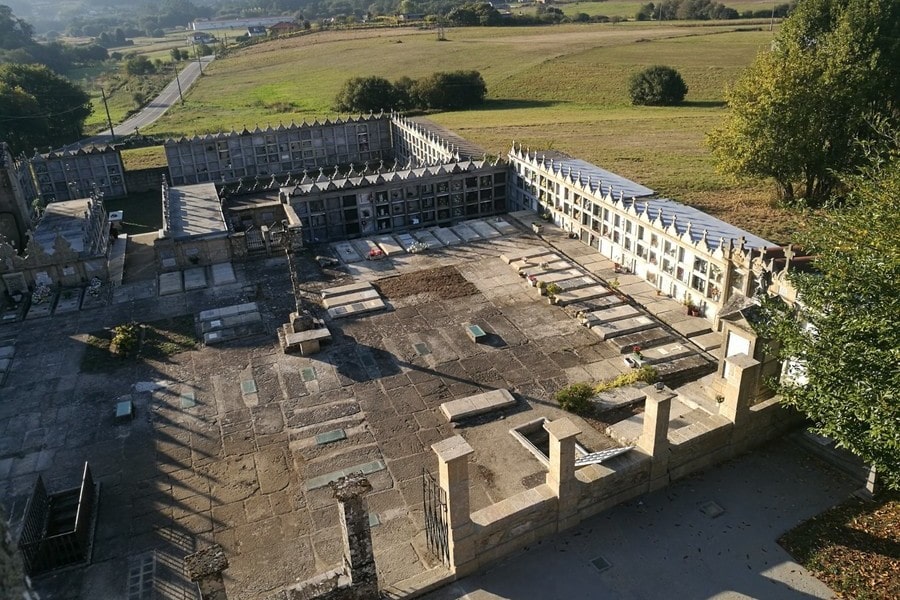Funerary art in Rías Baixas
The Pére-Lachaise cemetery, in París; the Chacarita cemetery, in Buenos Aires; the Poblenou, in Barcelona… In many cities and towns, cemeteries are among the main attractions. Apart from revealing the history of the place, some of them preserve elements that belong to our cultural heritage, and so in 2010 the European Council recognised the European Cemetery Route as a Cultural Route.
In the province of Pontevedra you can also find cemeteries of artistic and historic value, with pieces created by renowned sculptors, memorials of great figures and also monuments that commemorate important events in history. A tour is recommended to discover the funerary art in As Rías Baixas, including visits to the most significant cemeteries: Santa Mariña, in Cambados; Pereiró, in Vigo; San Mauro, in Pontevedra; the English cemetery, in Vilagarcía de Arousa; Os Eidos, in Redondela; and Arcos de Furcos, in Cuntis.
It should be noted that in Galicia tombs are usually placed vertically, in columns, grouping different members of the same family, in what is called a panteón.
Santa Mariña Dozo Cementery, Cambados
In Cambados, on the hillside of A Pastora, you can visit one of the most picturesque and beautiful cemeteries in Galicia, declared Historic and Artisitic Monument in 1943 and included in the Association of Significant Cemeteries in Europe. It is the Santa Mariña Dozo cemetery, which, according to the Galician writer Álvaro Cunqueiro, is "the world's most melancholic cemetery". Here you can admire the remains of an old church dating from the 15th century, built in the so-called Marine-Gothic style. The nave is roofless and you can visit the inside of the building to discover its arches with balls carved in the stone and adorned with sculptures depicting biblical scenes. Particularly striking is the representation of the seven deadly sins, such as the one representing sloth, depicted as a man eating his own faeces.
Around the temple, you can see the tombs of the cemetery of the parish. The members of the family who owned the manor house Pazo Bazán are buried here, as well as one of the sons and the wife of the writer Ramón María del Valle-Inclan, who passed away when the family was living in Cambados.
In the inside of the church, where only one mass is celebrated per year, on All Souls' Day, you can also see some tombs. This place is one of the must visits for travellers in Cambados.
Pereiró Cemetery, Vigo
Designed by the architect Jenaro de la Fuente, it is the largest and most monumental cemetery in Vigo and is famous for the value and quality of its sculptures. At the entrance, you are welcomed by a perfectly preserved hearse, the so-called Dodge "Carneiro", built in the ‘30s for the town council.
The burial places (panteóns) and monuments are part of an interesting and eclectic artistic complex, funded by the wealthy families of the town, and in some cases, by all the locals. The monolith dedicated to the lawyer and writer Concepción Arenal is considered an essential work of Galician modernism. It was designed by the architect Manuel Gómez Román, and built by the town council. It is also worth mentioning the mausoleum dedicated to the soldiers who passed away in Vigo, after being repatriated from Cuba and Filipinas, which shows a dying soldier. In this case, the work was commissioned by the Red Cross to the sculptor Julio González Pola, after receiving the wounded men and the dead bodies of the soldiers who passed away during the war.
Visitors will be amazed by the expressiveness of one of the most interesting sculptures, from an artistic point of view, which was created by the sculptor Francisco Asorey and commissioned by the Gil y Saraiba's family. The work depicts the moment when the Death takes one of her daughters, wrapping its arms around her back.
These are only some of the main points of interest in the cemetery, where some figures closely linked to the history of the town are buried. Some of these figures are the hero of the Reconquest of Vigo, Cachamuíña; the owners of the canning factories Alfageme, Massó and Albo; politicians such as José Elduayen Gorriti, the minister who abolished slavery in Spain; or Heraclio Botano, a leader of the labour movement assassinated in 1936.
San Mauro Cemetery, Pontevedra
San Mauro Cemetery, the largest in the town of Pontevedra, is a neoclassical construction designed in the late 19th century by the architect Alejandro Rodríguez-Sesmero, who played an important role in the expansion of the town to the outskirts.
As the old Cemetery of Eiriña turned out to be too small, it was planned the construction of a new one, which would open to the public in 1882. From that moment onwards, the cemetery underwent different transformations, among them, it stands out the enlargement carried out in the ‘60s, when the Romanesque San Mamede de Moldes Church was placed inside the graveyard.
In San Mauro Cemetery, you can find tombs from different periods and with different styles, columns, baldachins and mausoleums with a great architectural value. There are some remarkable mausoleums, as Ramiro Trapote's, made of marble; the Andrés Murais', built by public subscription; the writer and lawyer Indalecio Armesto's, having Mason symbols; and Eduardo Vicenti's and Dolores Montero's ones, which have bronze busts. In the cemetery, there is also a bust made by the sculptor Francisco Asorey on the tomb of the violinist Manuel Quiroga Losada. Another attraction is the panteón (burial place) of the family Sánchez Cantón, as there you can admire an image of Saint Francis which once belonged to the now disappeared Baroque Chapel Os Santos de Mollabao.
In addition, there is a civil area in the graveyard where some victims of the reprisals in 1936 (the year of the outbreak of the Spanish Civil War) are buried. Among them, the politician and supporter of the Galician nationalism, Alexandre Bóveda, and the philosopher, already mentioned, Indalecio Armesto.
Some guided visits of the cemetery have been organized by the town council of Pontevedra to discover its artistic and historic value. You can find more information about the artistic elements of this graveyard in a brochure of the local routes.
English cemetery in Vilagarcía de Arousa
This cemetery is on the list for its history, rather than its artistic value, as it shows the trace left by the British Army on the port of the town in the early 20th century. Those visits of the English sailors meant that the locals were known as "the English", a nickname still in use today among the people from the neighbouring towns of the region. The Cemetery of Vilagarcía de Arousa is the only English cemetery in the province of Pontevedra. In Galicia there is another one in the town of Camariñas.
The Naval Británico Cemetery, its official name, was built in 1911, nearby the municipal one, to bury the English deceased sailors who were not allowed to be entombed in the Catholic graveyard. It is a small area including a dozen of sculptures which is closed to the public most of the year. In the 70's, the British Consul in Vigo, Alexander Linsay, and his wife, who decided to be laid to rest in Galicia, were the last to be buried in the place.
Although the cemetery belongs to the British Army, the town council in Vilagarcía de Arousa acts as an intermediary between them and any prospective visitors. The cemetery only receives an average of three annual visits of English tourists attracted by the history of the British cemeteries. If you want to make a tour of the cemetery, you have to contact the town council as visits are only possible on request.
Os Eidos Cemetery, Redondela
This cemetery, located in the town centre of Redondela, was built in the 1830s. It has sculptures and mausoleums of great artistic value, the majority of them in the eclectic style. The mausoleum of the mayor Ramón Pardo Ferro stands out, having a sculpture of a blindfolded lady representing the faith. It is also remarkable, because of its strange symbols, the mausoleum of the lawyer Francisco Crespo Rivas, member of the Archaeological Society of Pontevedra, having a column crowned by a pyramid which was designed in Argentina. Other tomb with artistic value is that of the San Román family.
Os Eidos Cemetery was also involved in important historic events. Here, 42 Republicans who suffered reprisals during the Spanish Civil War were buried in a mass grave, and they are paid tribute with a commemorative plaque. It is also worth mentioning that one of the heroes of the Ponte Sampaio Battle, John O'Dogherty, who was in command of the local army to fight against the Napoleon troops in an attempt to recapture the cities of Vigo and Pontevedra, also lies in this cemetery.
Os Eidos Cemetery, which is no longer used, is open to the public. Now it belongs to the City Council, which will perform preservation and restoration works of all its monuments.
The cemetery of the parish of Arcos de Furcos, in Cuntis
This cemetery, built 5 metres under the ground in the ‘40s for practical reasons, is considered unique for being the only underground graveyard in Galicia. It is located in a beautiful spot by the San Breixo Church and was built to solve the problems of space of the old cemetery. Locals funded it and also participated actively in the construction works, taking earth away, and breaking and carrying granite from a nearby quarry.
There is a staircase leading to the catacombs, which are divided into two floors, having a total of 245 tombs grouped in 60 panteóns. Passages are endowed with electric light.
This cemetery in the province of Pontevedra, which belongs to the neighbours and is usually open to the public, is receiving an increasing number of visitors, who go to the place out of curiosity.







